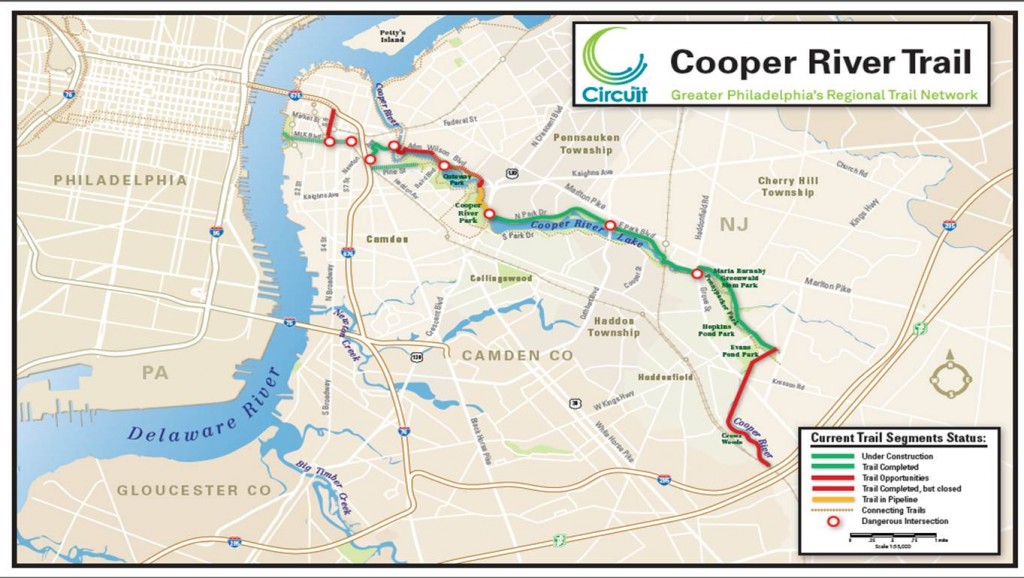
Pick any day to visit the Schuylkill River Trail in Philadelphia and you will see a fully-functioning commuter corridor — women and men bicycling and walking to work, while, across the river, motorists sit in miles of gridlock on the chronically jammed Schuylkill Expressway. Over a million people use the trail every year. But what makes this multi-use trail so attractive to commuters and different from other trails in the region? And what lessons can the Schuylkill River Trail offer for trail planners and builders across the state line in New Jersey?
The Cooper River Trail
Like the Schuylkill River Trail, Camden County’s (currently incomplete) Cooper River Trail corridor runs alongside a river and runs through a mixture of urban and suburban communities. But unlike the Schuylkill River Trail, which connects Center City Philadelphia with suburbs to the north, the existing segments of the Cooper River Trail remain disconnected and fail to form a coherent route that could be used by local commuters to reach centers of employment in Philadelphia and Camden. Closing these gaps — which is a key component of the Circuit regional trail initiative — is an essential step in producing a viable active transportation network.
Connections to on-road bicycle facilities and transit
Biking in Philadelphia has taken off as a transportation mode. In fact, the proportion of residents who cycle to work is the highest of the ten most populous cities in the United States (and nearly two and a half times higher than the rate in New York City) thanks in part to the Schuylkill River Trail and a growing network of on-street bike routes.
Camden and other communities along the planned Cooper River Trail corridor have recently seen bicyclist and pedestrian-focused improvements, with more on the way thanks to the Cooper’s Ferry Partnership, which plans to build more bike lanes throughout the City of Camden, and the Delaware Valley Regional Planning Commission, Camden County and the Delaware River Port Authority, all of whom are advancing plans to improve the biking and walking infrastructure around the Cooper River Trail corridor.
But in order for the Cooper River Trail to be as effective a commuter corridor as the Schuylkill River Trail, elected officials, trail builders and advocates must fully implement these plans and work together to improve the safety of on-road bicyclist and pedestrian travel throughout the region. Creating additional bike lanes will allow users to safely travel between currently disconnected Cooper River Trail segments (and allow residents to travel more safely between their homes and trail access points once the trail corridor is complete).

Economic development
The Schuylkill River Trail is a generator of major economic activity in Philadelphia. The sections of trail that are complete (or scheduled to be completed by 2015) are expected to produce 320 jobs in Philadelphia and 1,020 more statewide. The trail has also been a boon for residential properties within walking distance of trails in Philadelphia. According to a PennFuture study, these homes are valued between 4 to 7 percent higher than similar homes that lack easy trail access.
Filling in the Cooper River Trail’s gaps could have a similar impact. A 2013 Rutgers University study showed that walking and biking contributes nearly $500 million annually to New Jersey’s economy, and that there is an eight-to-one return on investment on bicycle and pedestrian infrastructure improvements in the state.
The time to capitalize on the strengths of the Cooper River Trail corridor is now
The success of the Schuylkill River Trail shows that there is a demand for safe multi-use trail commuting routes in the Greater Philadelphia/South Jersey region. By working to connect existing segments of the Cooper River Trail while simultaneously improving the on-road biking and walking network, area leaders, community groups, advocates and other stakeholders can create a safe and convenient non-motorized travel network. In order to do this effectively, transportation funds that can be spent on multi-use trails need to be made available. While the New Jersey Department of Transportation (NJDOT) has increased the proportion of transportation funds used on bicycle and pedestrian projects, these funds still made up only 2.8 percent of the 2014 Capital Program. NJDOT’s spending on bicycle and pedestrian projects should increase overall, and should also include a dedicated fund for regional trails.

[…] pedestrians and bicyclists are improving in Camden–there are now more bike lanes, multi-use trails and plans to enhance access to the Ben Franklin Bridge–but there is more work to do. There […]
[…] This intersection is adjacent to several sections of the Circuit Trail, including the Cooper River Trail and the North Park Drive Connector. The crash site is just a half-mile from the Cooper River Trail’s Pub Connector, which is pending design funding approval from the Delaware Valley Regional Planning Commission (DVRPC). This segment will be a critical link to connect the soon-to-open Gateway Park to other sections of the Cooper River Trail system. […]